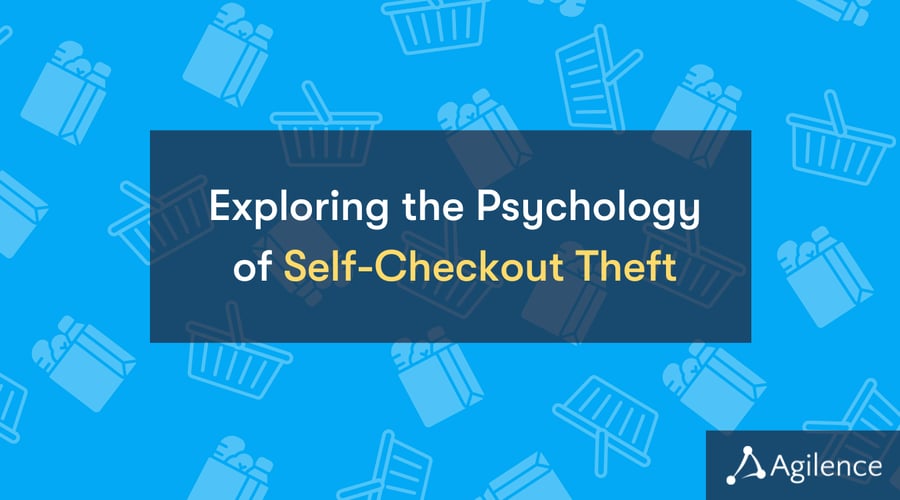Exploring the Psychology of Self-Checkout Theft
Grocery Retail
The mass adoption of self-checkout systems by grocers has been a significant shift towards efficiency and convenience for stores and shoppers alike. However, it’s also brought a shift in the psychology and dynamics of consumer behavior, with an unexpected consequence: a sizable increase in theft, including by otherwise law-abiding customers.
Why do self-checkout terminals have a higher rate of theft? Is it only because they are easier to steal from and so thieves take advantage, or does something about their design encourage theft among customers who otherwise wouldn’t steal?
In this article, we’ll explore this question and the psychology of self-checkout theft, particularly as it applies to shoppers who would typically not commit criminal acts. We’ll look at some of the psychological effects of self-checkout design, typical types of self-checkout thieves, and common excuses used to justify self-checkout theft.
Does the Impersonal Nature of Self-Checkout Encourage Theft?
So does self-checkout encourage theft by everyday shoppers, or is it just that thieves like to target self-checkout lanes?
The answer seems to be… both.
Certainly, the fact that it’s easier to steal from self-checkout encourages thieves to take advantage of it. Interviews with self-checkout theft offenders revealed that the “main reason offenders leverage this theft option is because they felt self-checkout theft is easier to get away with, either through prior experiences or established rationales.” Offenders indicated if caught, they could say they misused the technology, they’d been distracted, or it was an accident, and many are under the impression that self-checkout is harder to prosecute because it’s harder to prove intent. There is a clear appeal of self-checkout theft to your typical shoplifter.
But while self-checkout can be taken advantage of by those with criminal intent, is that the sole reason for elevated theft levels – or is there something about the format itself that encourages theft?
The increased use of self-checkout in grocery stores has notably diminished the personal interaction that traditionally accompanied transactions, influencing the moral dynamics of theft for everyday shoppers. The impersonal nature of self-service checkouts tends to obscure the ethical boundaries for some individuals, making theft appear less consequential due to the absence of direct human judgment or disapproval.
This perceived anonymity and reduced oversight at self-checkout stations contributes to a diminished sense of accountability among some shoppers who otherwise would not engage in shoplifting. Research indicates that individuals are more likely to engage in unethical behavior when they believe they are not being observed, suggesting that self-checkout systems might inadvertently encourage theft by offering a sense of invisibility.
Let’s take a look at some of the psychological concepts that underlie the phenomenon of self-checkout theft.
Psychological Explanations for Self-Checkout Theft
Diffusion of Responsibility and Deindividuation
The anonymity of self-checkout purchases creates a different psychological environment for shoppers than the normal checkout line. Psychological concepts such as diffusion of responsibility and deindividuation can offer some insight into why individuals may feel more inclined to steal in self-checkout contexts. Diffusion of responsibility theory suggests that individuals in a group (or in this case, users interacting with a machine rather than a person) are less likely to feel personally accountable for negative actions, while deindividuation refers to the loss of self-awareness and erosion of personal standards when individuals are part of a group.
However, these sociopsychological phenomenon don’t apply only to human behaviors in large groups, but increasingly, to how people behave when dealing with machines. In the context of self-checkouts, the interaction with a machine instead of a person can create a sense of anonymity, even in a public setting, that can lower inhibitions against theft, as individuals feel less identifiable and therefore less accountable for their actions. By not directly interacting with another human being, the shopper’s sense of personal responsibility for the action is diluted.
The "Spotlight Effect" and Moral Decision-Making
The "spotlight effect" describes the tendency of individuals to overestimate the extent to which their actions are noticed by others. In traditional checkout lines, the presence of cashiers and other shoppers may amplify this effect, discouraging theft due to the perceived risk of being observed and judged. However, at self-checkout stations, where observation by others is greatly reduced, this psychological deterrent diminishes. Shoppers may feel less "in the spotlight" and thus more comfortable engaging in theft, under the assumption that their actions are not being scrutinized as closely.
Opportunity Theory in the Context of Self-Checkout
Opportunity theory provides a crucial lens through which to understand the dynamics of theft at self-checkout stations. Opportunity theory posits that an individual's decision to commit a crime is significantly influenced by the presence of a perceived opportunity within their normal routine or environment. In the context of retail self-checkouts, this means that the very design and operation of these systems can inadvertently create opportunities for theft, influencing shopper behavior in ways that might not occur with traditional cashier-operated checkouts.
The design of self-checkout stations offers a degree of autonomy and privacy not available in manned checkout lanes. This autonomy, while enhancing customer convenience, also reduces the perceived risk of detection for potential thieves. A 2006 research paper highlights how the physical cues within the retail environment influence shoplifter perceptions, suggesting that the layout and design of self-checkout areas can significantly impact the decision to steal. The isolated nature of these kiosks, combined with the often busy and distracted store environment, creates a prime opportunity for theft.
A 2016 study by the University of Leicester led by retail expert Adrian Beck also highlighted the unintended consequences of self-scanning technologies in retail spaces. Beck suggested that by minimizing human interactions, self-checkout lowers the risk perceived by potential thieves, thus fostering an environment where theft becomes more tempting. Beck has pointed out that individuals who engage in theft at self-checkout are not habitual offenders but are rather ordinary customers who stumble upon an unexpected opportunity to take something without paying, like a frozen pizza that wasn't scanned properly. This phenomenon indicates that the design of self-checkout systems could unintentionally encourage theft among those who would normally not consider stealing.
Neutralization Theory and Self-Checkout Theft
Another intriguing lens through which to view the behavior of theft at self-checkout stations is Neutralization Theory. This theory, initially developed by Gresham Sykes and David Matza in the late 1950s, delves into the cognitive gymnastics offenders perform to justify their crimes.
At its core, Neutralization Theory proposes that individuals drift between law-abiding behavior and delinquency based on their ability to “neutralize” conventional moral values. In other words, even those who commit theft often subscribe to general societal norms but find ways to "turn off" their internal moral compass when it comes to specific acts of stealing.
When we apply Neutralization Theory to the environment of the self-checkout, we begin to understand the mental loopholes shoppers might jump through to alleviate guilt or justify theft. The impersonal nature of self-checkouts, combined with the occasional frustrations they present (like misreading barcodes or unresponsive interfaces), provides fertile ground for these rationalizations. Sykes and Matza broke down justifications by criminals into five categories, which we can apply to self-checkout theft.
- Denial of Responsibility: "The machine wasn't working right, so it's not really my fault."
- Denial of Injury: "This corporation makes millions; they won't miss a few dollars."
- Denial of the Victim: "These prices are too high anyway; I'm just leveling the playing field."
- Condemnation of the Condemners: "The staff here are rude and don't help, so why should I bother being honest?"
- Appeal to Higher Loyalties: "I need to save money any way I can for my family."
Excuses and Justifications for Self-Checkout Theft
Understanding these justifications can offer loss prevention professionals a deeper insight into the psyche of self-checkout thieves, enabling more targeted strategies to curb this behavior. Here are some of the most common excuses and justifications for self-checkout theft.
"The Big Corporation Can Afford It"
A prevalent justification is the perception that taking an item or two won't really hurt the store's bottom line. After all, they're big companies making big profits, right? They may perceive the store as a greedy and faceless corporation who profits at the expense of the little guy. The customer can’t point to someone who is going to lose money if they steal, so it seems like a victimless crime.
The Protest Theft
Related to this, some shoppers purposefully steal from self-checkout as a form of protest against the technology, seeing it as taking jobs away from people just to enrich the company. According to one shopper, "If they are going to make me self-serve and reduce the employment for our youth, I will help myself to almonds and mushrooms at potato prices and make sure I hit their bottom line.”
"They Owe Me"
Despite their promise of efficiency, self-checkout systems can often be cumbersome to use, especially if the self-checkout area is short-staffed. Sometimes a frustrated shopper believes that if the machine or the store has inconvenienced them, it's only fair to compensate themselves. It may be triggered by mis-scans or other annoyances from the machine, a long line or lack of timely help from an attendant when needed, or simply because the shopper feels that by “doing the work” a store employee “should” do, they are owed something in return. Also, with the recent rise in price inflation, shoppers may feel that they are just purchasing goods at what the price “should be.”
"It's Just a Small Item"
The trivialization of theft by minimizing the value or size of the stolen item is another common tactic. Some consumers see self-checkout lanes as an easy target, feeling morally justified in stealing small items under the guise that it's inconsequential.
"Everybody Else Is Doing It"
The normalization of theft in self-checkout scenarios can also play a significant role. When people observe others bypassing scanning items or hear stories of successful thefts, it can lower their inhibitions, fostering a 'bandwagon' mentality.
Psychological Profiles of Self-Checkout Thieves
Diving into the world of self-checkout theft, not all thieves are cut from the same cloth. Far from the stereotypical shoplifter, the profiles of individuals who engage in theft at self-checkouts are as varied as the products they discreetly slip into their bags. Let's explore the psychological makeup of these modern-day pilferers.
The Opportunistic Shopper
First up, we have the Opportunistic Shopper. This individual doesn't walk into the store with the intent to steal but finds themselves tempted by the ease and perceived anonymity of the self-checkout. A study from the Journal of Applied Psychology highlighted that theft occurs four times as often at self-checkout kiosks compared to manned stations, suggesting that the opportunity itself plays a significant role in encouraging otherwise law-abiding citizens to commit theft.
The Calculated Thief
On the other end of the spectrum is the Calculated Thief, someone who enters the store with a clear plan to exploit self-checkout systems. These individuals are well-versed in the various tricks of the trade. Their actions are premeditated, and they often keep abreast of technological and procedural changes to stay one step ahead.
The High-Income Shoplifter
Perhaps surprisingly, income level doesn't always deter theft. According to Business Insider, those with incomes over $100,000 are more likely to admit to stealing at self-checkouts. This demographic might not be stealing out of financial necessity but rather for the thrill or the challenge. Some may also steal as a “silent protest” against bagging their own groceries.
The Entitled Compensator
Justified by the belief that self-service saves retailers money at the expense of customer convenience and jobs, some shoppers feel entitled to "compensate" themselves by stealing, also driven by resentment toward automation and supermarket dominance.
The Emotional Shoplifter
Theft isn't always driven by financial or opportunistic motives; sometimes, it's an emotional act. Triggered by frustrating experiences such as "unexpected item in the bagging area" errors, some customers justify theft as a response to their irritation, using excuses similar to those used by burglars, questioning whether the intent to steal was present before or arose due to the self-service system.
The Accidental Thief
Initially unintended, this type of theft becomes habitual for some as they realize the ease with which they can take items, especially after a first incident that occurs by accident or due to scanning issues.
Stopping Self-Checkout Theft
Understanding the psychology behind self-checkout theft can help loss prevention professionals in the fight to reduce it. Techniques such as mirrors to encourage self-awareness by shoppers during the self-checkout process, conspicuous surveillance devices, and increasing the number of attendants can all help to minimize the psychological phenomenon explored above.
However, deterrence isn’t enough. A data analytics tool such as Agilence Analytics can provide an invaluable mechanism to identify and reduce self-checkout fraud. By analyzing transaction, video and inventory data with Agilence, users can discover both general patterns of theft as well as specific instances, identifying repeat offenders, stolen items, attendants with excessive abandoned orders, and much more. Suspicious transactions can also be automatically flagged, such as above-average weights for a given bulk item, and an automated alert can be sent to a store manager or attendant to investigate the transactions immediately.
Learn more about combating self-checkout theft with analytics.
Related Articles

How to Identify and Reduce Self-Checkout Theft and Fraud
Nearly every major retail grocery brand now has self-checkout as a self-service alternative to traditional cashier-staffed ch...
11 Types of Retail Fraud on the Rise Across the Customer Journey
Dealing with fraud is no new task to retailers, but over the years fraud techniques have developed that could bring harm to y...
"What's My Banana?" Applying the Banana Trick to Other Industries
With today’s ever-increasing landscape of automated processes that are being deployed throughout the retail, grocery, restaur...Subscribe to our blog
Receive free educational resources like exclusive reports, webinars, and industry thought leadership articles straight to your inbox.

